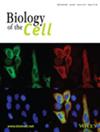DeepSCEM:细胞电子显微镜中基于深度学习的图像分割的用户友好解决方案
IF 2.4
4区 生物学
Q4 CELL BIOLOGY
引用次数: 0
摘要
使用卷积神经网络的深度学习方法在自动图像分割任务中非常有效,细胞电子显微图也不例外。然而,缺乏专用的易于使用的工具在很大程度上减少了这些技术的广泛使用。在这里,我们介绍了DeepSCEM,这是一个使用深度学习对细胞电子显微镜图像进行快速有效分割的简单工具,特别侧重于高效和用户友好的细胞器分割模型的生成和训练。本文章由计算机程序翻译,如有差异,请以英文原文为准。

DeepSCEM: A User-Friendly Solution for Deep Learning-Based Image Segmentation in Cellular Electron Microscopy
Deep learning methods using convolutional neural networks are very effective for automatic image segmentation tasks with no exception for cellular electron micrographs. However, the lack of dedicated easy-to-use tools largely reduces the widespread use of these techniques. Here we present DeepSCEM, a straightforward tool for fast and efficient segmentation of cellular electron microscopy images using deep learning with a special focus on efficient and user-friendly generation and training of models for organelle segmentation.
求助全文
通过发布文献求助,成功后即可免费获取论文全文。
去求助
来源期刊

Biology of the Cell
生物-细胞生物学
CiteScore
5.30
自引率
0.00%
发文量
53
审稿时长
>12 weeks
期刊介绍:
The journal publishes original research articles and reviews on all aspects of cellular, molecular and structural biology, developmental biology, cell physiology and evolution. It will publish articles or reviews contributing to the understanding of the elementary biochemical and biophysical principles of live matter organization from the molecular, cellular and tissues scales and organisms.
This includes contributions directed towards understanding biochemical and biophysical mechanisms, structure-function relationships with respect to basic cell and tissue functions, development, development/evolution relationship, morphogenesis, stem cell biology, cell biology of disease, plant cell biology, as well as contributions directed toward understanding integrated processes at the organelles, cell and tissue levels. Contributions using approaches such as high resolution imaging, live imaging, quantitative cell biology and integrated biology; as well as those using innovative genetic and epigenetic technologies, ex-vivo tissue engineering, cellular, tissue and integrated functional analysis, and quantitative biology and modeling to demonstrate original biological principles are encouraged.
 求助内容:
求助内容: 应助结果提醒方式:
应助结果提醒方式:


